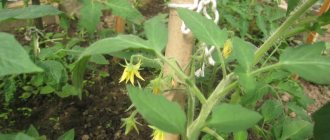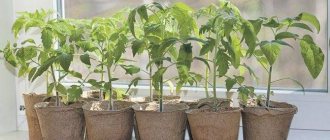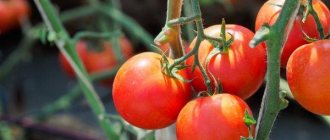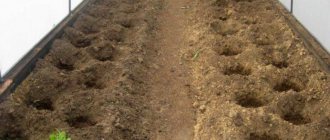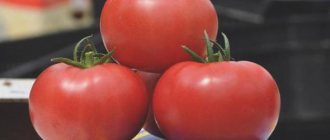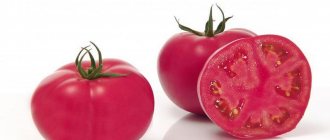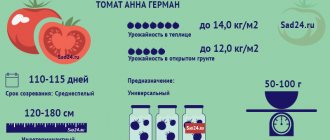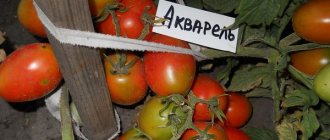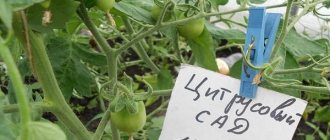In the new summer season, each gardener will have to choose which tomatoes he will grow this year. Summer residents of the North Caucasus region have an excellent opportunity to provide themselves with a large number of delicious pink fruits. To do this, you need to plant Bush Pink hybrid tomatoes on the plot.
| Height | Landing location | Ripening time | Fruit color | Fruit size | Origin | Fruit shape |
| short | Open ground | Early ripening | Pink | Average | Hybrid | Round |
History of the variety's creation
The Pink Bush tomato was bred by breeders from Japan at the end of the last century, and not only local farmers, but also farmers from other countries of the world immediately became interested in it. The main advantages of the variety are the compactness of the bushes, a large number of fairly large fruits of pink color, a pleasant sweetish taste, which simultaneously ripen on the bushes.
The Pink Bush tomato was included in the Russian State Register in 2003
and was recommended for cultivation in open ground and in greenhouse conditions.
Growing tomatoes
In most regions, cultivation is carried out through seedlings. In the Astrakhan region or Crimea, direct planting of seeds in open ground is also practiced. In this case, sowing is carried out 1-2 months later, when the average daily temperature is fixed at 18-20*C.
How to prepare seeds?
The originator of the hybrid, the Japanese exports the seeds already disinfected, stimulated and ready for planting. To avoid infecting them with third-party bacteria during work, you should follow the rules of hygiene :
- Manipulate with disposable gloves;
- Disinfect containers and equipment with chlorine solution;
- Heat garden soil to 60*C before use.
The only thing that needs to be done before sowing is to soak the seed material in melt water at room temperature for 12 hours. Seeds saturated with moisture open faster and sprout immediately when they fall into the substrate.
Sowing seed material
Seeds are sown 35-45 days before planting in a permanent place. Seedlings that are overexposed in a pot stop developing, and those planted prematurely may die, so the sowing date must be calculated responsibly. To do this, 35 days are subtracted from the date of the last return frost, thus leaving 10 days in reserve in case of unforeseen weather deterioration.
The main thing you should pay attention to when planting seeds is temperature conditions.:
- After sowing, the seedling container is covered with polyethylene to create a greenhouse effect of 28-30*C.
- With the appearance of the first sprouts, the film is removed and the seedlings are placed for 3 days in a cool room with a temperature of 15*C during the day, 12*C at night. This is done to prevent the stem from stretching and to stimulate the root system;
- The main stage of cultivation occurs at a temperature of 20-25*C and at least 15*C at night.
Seedlings require long daylight hours (at least 14 hours), moderate watering, ventilation (excluding drafts) and complex fertilizing once every 2 weeks. After the formation of the 2nd true leaf, the bushes are picked into individual containers. It is best to plant in peat pots or paper cups - this will save sensitive plants from additional replanting when transferred to a permanent bed.
Rules for planting seedlings
Planting is carried out when the ground warms up to 10*C and the air warms up to 12*C.
During the first week, it is advisable to cover the shoots with film at night to protect them from hypothermia. Recommended landing pattern :
- The interval between plants is 50 cm;
- Row spacing – 60 cm;
- Planting hole depth 15 cm;
- The maximum planting density is 5-6 bushes per 1 sq.m.
Main characteristics and description of the variety
This hybrid is classified as an early ripening tomato variety.
– from the moment of germination of the seed material to the harvesting of ripe tomatoes, a little more than 3 months pass.
In regions with a warm climate, the Pink Bush variety can be planted in open ground, but in the Urals, Siberia and other regions with similar climatic conditions, it is better to grow this variety in greenhouse conditions.
Photo of Pink Bush tomato
Experts include the main advantages of tomatoes with pink colored fruits:
- they contain a sufficient amount of lycopene, carotene, vitamins, macro- and microelements, organic acids;
- Pink fruits contain a lot of selenium, which helps strengthen the immune system and improve brain function;
- the beneficial substances found in such tomatoes help improve the functioning of blood vessels;
- fresh and canned tomatoes contain substances that are recommended for the prevention of cancer;
- Regular consumption of rose-fruited tomatoes helps fight depression.
Tomato Pink Bush - video
Hybrid Pink Bush is classified as a determinant type
– its shoots are limited in growth, an inflorescence usually forms at the top, and further growth of the stem stops. Shoots in height can reach 0.5-0.6 m when grown in open ground garden beds and up to 0.75 m when grown in closed ground.
The central shoot is medium-powerful, strong, and can easily withstand the load of ripening fruits. The shoots are well leafy, the foliage is large, of a typical tomato shape, dark emerald in color, and is capable of sheltering ripening tomatoes from the scorching rays of the sun.
TOMATOES!
Tomato Big Momma Tomato Evpator f1 Tomato Olya F1
Important!
Pink Bush tomato bushes do not require staking, as the shoots are compact. However, if mulch is not added to the tree trunk circles, then it is better to tie up the racemose inflorescences so that the tomatoes do not lie on the ground.
The flowers are small in size, yellow in color, collected in racemose inflorescences, each of which can have up to 4-7 ovaries.
Ripe tomatoes of this variety are round in shape, regular, bright pink in color. The first tomatoes harvested are more flattened than the fruits from the subsequent harvest. The skin of tomatoes is smooth, with a characteristic shine, thin, but dense, not prone to cracking.
Photo of Pink Bush tomato pulp
In each cluster, the size and weight of the fruit are the same, their weight is about 190-210 g, each tomato contains 6 seed chambers with a sufficient amount of seed material. Tomatoes are fleshy, juicy, sweet, with a slight sourness. 100 g of product contains up to 7.5% dry matter.
But the taste of Pink Bush tomato fruits may vary when grown in different types of soil with different structures. In addition, the taste of pink fruits can be affected by lower temperatures and reduced light levels.
INTERESTING!
Varieties of black tomatoes
The collected fruits are distinguished by their versatility of purpose - they can be eaten fresh, added to vegetable salads and other snacks, and can also be preserved.
The crop withstands transportation well at any distance, while the fruits do not crack or deteriorate, and their appearance does not deteriorate.
After picking, ripe tomatoes can lie for a long time, especially in the refrigerator.
Pink Bush Tomato bushes do not require shaping, and stepchildren also do not have to be removed.
Outdoor care
Basic measures for caring for tomatoes in the ground:
- regular weekly watering;
- fertilizing with fertilizers once every 2 weeks;
- microclimate control and making adjustments;
- maintaining the shape of the bush: gartering, pinching;
- prevention and control of diseases and pests.
Watering
For good seedling development, the soil must contain a sufficient amount of moisture, so watering is carried out weekly. The irrigation rate for 1 adult bush is 12 liters of water per week. In modern vegetable growing, drip irrigation is used to apply moisture directly into the soil under low pressure - this way the plants are not stressed due to cold water or drops falling on the leaves. Excess moisture can attract pests.
Fertilizer application
Feeding is usually carried out at least 3 times. The first is 2 weeks after planting in a permanent place, the second is no less than 15 days later in the budding phase, and the third is another 2 weeks later. Basic fertilizers: nitrogen, potassium, phosphorus. They can be part of a complex mixture or used as separate fertilizers.
Check out the best recipes for feeding tomatoes with yeast.
You can use fertilizers of organic origin containing the above substances, or purchase synthetic industrial preparations at the store. The list of typical synthetic fertilizers includes:
- ammonium nitrate;
- superphosphate;
- potassium sulfate.
In order to correctly calculate the amount of fertilizer needed, it is important to know what and how much is in the greenhouse soil
If it is not possible to establish the exact composition, pay attention to indirect signs of excess or deficiency of microelements based on the condition of the plants. If you are not sure, start with half the amount indicated on the fertilizer package. Did you know? The first documentary evidence of the use of organic fertilizers dates back to Ancient Japan
There the plants were fertilized with feces. At the same time, the manure of the rich was considered more useful, since they ate better, which means they produced a higher quality product
Did you know? The first documentary evidence of the use of organic fertilizers dates back to Ancient Japan.
There the plants were fertilized with feces. At the same time, the manure of the rich was considered more useful, since they ate better, and therefore produced a higher quality product.
Stepsoning
Pinching is the process of removing side shoots. The main goal is to direct nutrients to fruiting. If this is not done, the bush will form a lot of leaves, but there will be very few fruits. Side shoots appear in the axils of the main stem; they must be pinched off at a height of 0.5 cm.
The Pink Unicum F1 variety is an indeterminate variety and theoretically can grow to any height. Even the manufacturer’s stated height of 1.5 m may not be very comfortable. If you want to stop the growth of the bush, simply pinch its top. Be sure to also remove lower leaves as the bush develops, as they can provide easier access for various fungi to infect.
Soil care
Among the main soil care measures:
- weeding;
- aeration (loosening);
- mulching;
- hilling.
Loosening tasks include:
- improving oxygen supply to roots;
- weed control;
- pest control.
Did you know? There are wild varieties of tomatoes also belonging to the genus Solanum. Their fruits are smaller; some of them are poisonous. If you come across a wild variety of tomatoes, do not eat it unless you are sure of its edibility.
Tying up bushes
Just as humans need a skeleton to walk upright, tomatoes need support to maintain an upright shape, support the weight of ripening fruits and prevent diseases associated with excess moisture. Tall Pink Unicum F1 tomatoes in a greenhouse can be tied to a vertical trellis.
Read more about how to properly tie up tomatoes.
As the plant grows, it is simply pulled up to the ceiling of the greenhouse. A vertical trellis is a cord attached to the top of the greenhouse.
Also keep in mind that the yield of the variety in a greenhouse is higher than if it were grown in open ground - therefore the cord must be comfortable enough to hold up to 9 kg of fruit weight. The garter makes it easier to care for plants: they are easier to water, fertilize, hill up and perform other agrotechnical procedures.
Advantages and disadvantages
Tomato Pink Bush is a variety of Japanese selection that has the following advantages:
- high productivity;
- excellent taste and appearance of ripe pink tomatoes;
- the harvested crop is not subject to cracking, can easily be transported over any distance, and has good shelf life;
- the color of ripe tomatoes is uniform, even around the stalk there is no green spot, characteristic of many other varieties of tomatoes;
- the harvest is suitable for dietary nutrition;
- bushes of this variety are highly resistant to many diseases characteristic of other tomatoes;
- The Pink Bush variety is unpretentious and does not require pinching, plant formation, or removal of excess foliage.
There are no disadvantages noted in the Pink Bush tomato. However, due to the fact that this tomato is a hybrid, you have to buy seed material anew every year, and its price is quite high.
Diseases and pests
Due to high disease resistance, only prevention is necessary for this type of tomato. Compliance with watering and lighting regimes, fertilization and timely loosening of the soil will save gardeners from tomato diseases.
When grown in greenhouses it is often susceptible to greenhouse whitefly. Confidor is used against it, at the rate of 1 ml per 10 liters of water, the resulting solution is enough for 100 square meters. m.
Ash and hot pepper are used against slugs by sprinkling them on the soil around the plants. You can get rid of ticks using a soap solution.
“Pink Bush F1” will delight gardeners with its very beautiful and tasty fruits, and next year you will have this wonderful tomato in your garden again. Good luck and a good harvest on your plot!
Planting seedlings
In most Russian regions with fairly cool summers, this tomato is planted using the seedling method.
On a note!
Pink Bush tomato seeds should be sown for seedlings in mid-March, 1-1.5 months before transplanting the seedlings to a permanent location. Depending on the climatic characteristics of a particular region, vegetable growers themselves specify the dates for sowing Pink Bush tomato seeds for seedlings.
Seeds can be planted in ready-made soil mixture purchased in specialized stores. But you can cook it yourself in the autumn. To prepare a nutrient substrate, garden soil, humus and sand (or peat) are mixed in equal parts, and wood flour should also be added as a fertilizer.
Photo of Pink Bush tomato seedlings
Before placing it in containers, such a homemade nutritious substrate must be disinfected:
either calcined in the oven for 30 minutes at a temperature of 150 degrees, or spilled with a weak solution of potassium permanganate and left until completely dry.
Then the nutrient soil is scattered into containers and moistened. Seed material is laid out on top and sprinkled with soil mixture to a depth of 1.5-2 cm.
Cover all containers with polyethylene on top and put them in a warm place where the temperature is maintained at about 25 degrees Celsius. The polyethylene is opened slightly every day to ventilate the plantings.
After 6-8 days, friendly shoots appear. The polyethylene must be removed and the containers moved to the windowsill. In the first 7 - 8 days, seedlings should be kept at a daytime temperature of about 16 degrees, and a night temperature of about 13 degrees Celsius.
It takes 10-10.5 hours to illuminate the plants during this period.
Tomato Pink Bush second revolution, planting seedlings - video
Then the room temperature is raised to 21-22 degrees and maintained for the next 30 days.
Important!
After the Pink Bush tomato seedlings have at least 2 true leaves, they should be picked out and each sprout transplanted into a separate container.
During the growth process, seedlings should be regularly watered and fed. Watering is carried out as the top part of the soil dries out. During the growth period, Pink Bush tomato seedlings are fed at least twice. As a top dressing, it is best to use a purchased complex mineral fertilizer for tomato seedlings.
How to care for tomatoes in open ground
Care after picking to a permanent place is quite simple. It is necessary to follow basic rules of agricultural technology and check the bushes for damage and damage by pests or fungi.
Watering
Watering is carried out on demand. In open ground, climatic conditions serve as a guide. During the rainy season, it is completely excluded; if necessary, the holes are mulched with dry soil or the top layer of soil is changed to avoid the growth of the fungus. In closed ground, they focus on the drying out of the earthen coma.
The best option is to organize automated drip or ditch irrigation. This will allow water to be supplied directly to the root without splashing it onto the green part.
Did you know? Wild tomato fruits can weigh no more than 1 g, and cultivated varieties can reach 1.5 kg.
Feeding
Feeding is carried out at intervals of 2-3 weeks, if growth is delayed - once every 10 days.
The standard fertilizer application scheme looks like this:
- 7 days after landing;
- during the flowering period;
- in the fruit set phase;
- in the fruit filling phase.
Organic or mineral mixtures are used as fertilizer. At the initial stage of development, plants need nitrogenous fertilizers. They contribute to the accelerated growth of the ground part. A good option is to water it with an ash solution. Add 400–500 g of ash to 10 liters of water and boil for 5 minutes. After cooling, pour 500–800 ml into the wells. During the flowering period, you need to feed the plants with liquid mullein. During the fruit setting and filling phase, complex mineral supplements containing phosphorus, potassium, and calcium will be required. A suitable option is nitrophoska. Add 50 g of substance to 10 liters of water. Each plant will require 300–500 ml of working solution.
Pinching and tying up bushes
Plants do not need pinching. Tying is carried out at the moment of fruit ripening to help the bushes hold a lot of weight. Begin tying in the fruit formation phase. For low-growing tomatoes, ready-made mesh frames are suitable. They are simply put on the plants and the fruiting branches are attached to the supports using a rope. The technique is effective, but when growing tomatoes over large areas it is too expensive.
Important! Pinching the lower shoots may be necessary when air humidity increases due to large amounts of precipitation. In this case, all leaves and branches located closer than 15 cm from the ground level are removed
A more budget-friendly option is to attach the shoots to a mesh installed between the rows. The advantage is the ability to secure 2 plants at once on both sides of the mesh.
Soil care
Loosening the soil and removing weeds is carried out after each watering, precipitation and application of root fertilizers. After loosening the soil in the holes, mulch with compost.
Further care for Pink Bush tomatoes
In the first days, Pink Bush tomatoes are watered frequently so that they quickly acclimatize to a new place. In the future, the amount of watering is reduced, adding moisture as the soil dries out.
In the middle zone and other regions with similar climatic conditions, it is recommended to remove the shoots that form in the leaf axils so that the bushes direct all the nutrients to ripen the tomatoes.
general information
Pink Unique tomatoes are in great demand among buyers, and therefore farmers and large farms have given them preference. They are also perfect for growing in the country.
The tomato is included in the State Register of the Russian Federation “for growing under film covers on private farms.”
- The variety belongs to the indeterminate type and grows up to two meters.
- Mid-season hybrid F1.
- From seed germination to the first fruit, 110–120 days pass.
- High yields: 5–6 kg can be harvested from one bush. It all depends on the growing region.
- The racemes are small, but form up to six flower branches on the stem.
- Universal purpose. They are good fresh and canned.
- Medium-sized fruits set well, from 5 to 7 pieces per branch, if you provide care.
- For planting in greenhouses or film shelters.
Reviews from those who planted the Pink Bush tomato variety
Lyudmila, 58 years old, Kursk: Last year, together with our neighbors in our summer cottage, we bought a Pink Bush tomato to try. And they were right. The bushes turned out to be compact. I planted 5 seedlings on one square. Caring for these tomatoes is standard - watering, fertilizing, loosening. As a result, I collected 2 kg of large sweet tomatoes from each bush. The fruits ripened together - within 10 days after the tomatoes began to ripen, the entire harvest was harvested. Enough for food and spins.
Elena, 45 years old, Astrakhan region: Of the early tomatoes on my plot for the last few years, I have only been planting the Pink Bush variety. We first grow seedlings at home, and in mid-May we plant strong, healthy seedlings in open ground on ridges. The harvest ripens together, by mid-July we get 10 kilograms of tomatoes per square area.
Natalya, 39 years old, Belgorod region: In my polycarbonate greenhouse I always leave a bed or two for Pink Bush tomatoes. The bushes of this variety are compact; I plant 6 bushes on one square. The ripening of the fruits is uniform, the fruits are even and smooth. Moreover, this hybrid ripens early, I recommend it to everyone.
The tomato hybrid Pink Bush is distinguished by good yield, excellent appearance and taste of pink fruits, as well as high immunity to most diseases.
Therefore, these tomatoes are actively planted in many countries of the world, including Russia.
Agricultural technology
Grape Relines Pink Seedlis
Painstaking care of the Pink Bush tomato variety is required when germinating seeds. An adult plant in a greenhouse or on a plot does not need so much effort. Let's consider the details of agricultural technology during cultivation.
Note! Leaves and fruits do not suffer from sunburn
Soils
To ensure a harvest, the planting site must be properly prepared. Nutritious fertile soil is needed, for which the following is added to the soil:
- humus;
- ammonium nitrate;
- ammophosis;
- in the case of a clay structure, add sand, 1/2 bucket per 1 sq. meter.
For acidic soils, additives are used: dolomite flour, ash, chalk.
Sowing
The variety is sown in fertile soil, specially prepared, deepened by 0.5 cm. There is no need to additionally soak or treat the seed with stimulants. The soil is moistened with a spray bottle, after which the container is covered with film. In a microgreenhouse, tomatoes sprout and develop for the first time. The container should be kept warm at 24 or 26 degrees.
Sow the seeds
After the seedlings appear, the container is placed in the light, in a cool place (15 degrees C), so that the tomatoes harden. There are standards for growing seedlings, according to which the plant will be healthy and stronger:
- illuminate at least 10 hours a day;
- The seedlings are kept at 15 degrees for 10 days for hardening;
- subsequently the temperature is increased gradually, up to 20 degrees;
- after 2 true leaves, they are picked and transplanted into separate pots;
- The next step is fertilizing using complex fertilizers.
If seedlings grow excessively, tomato bushes may weaken, which will affect the harvest. In this case, remove a couple of lower leaves and place the tomato on its side, covering it with earth.
Transplantation into the ground
Pink Bush can be grown in open ground only in the southern and central regions. The seedlings are transferred to the garden bed after 40 or 50 days. Up to 5 bushes are placed per square meter, but not more densely, otherwise the yield will decrease and the risk of diseases will increase.
Planting sprouted seedlings
When transferring to the ground, plants with a lump of earth are taken out of containers (transfer). The hole is filled, compacted and watered with warm water. Having mulched the soil around the bush, do not loosen the soil or water it for 10 days.
Fertilize with manure
When planting, the land must be prepared. Manure, humus or mineral fertilizer are added to it.
Outdoor care
After transplantation, there are no particular difficulties in caring for the Pink Bush variety. Only standard rules should be followed:
- Watering is carried out as necessary, determined by climate conditions. If tomatoes grow in a greenhouse, wait until the top layer of soil dries. Excess moisture should be excluded, because the fruits will be watery, their sugar content will decrease, they may crack and become infected with fungal diseases;
- Fertilizing is done when seedlings are transplanted into the soil, and complex mineral fertilizers for tomatoes are also applied every 2 or 3 weeks. If growth is weak, this is done once every 10 days. The first feeding is a week after transferring the plant to the garden bed, when flowering is in progress. The second is when the fruits are filled. The third - also during the fruiting period;
- Air humidity should be maintained at 50% and soil humidity at 90%;
- A garter is required due to the high yield. Trellis are installed in greenhouses;
- There is no need to pruning, but a couple of bottom sheets are removed weekly. This will provide protection against a number of diseases.
We water correctly
It should be said about possible mistakes. There is no need to sow the same variety in one place for many years. It is also recommended to apply fertilizers on time.
Diseases and pests
Pink Bush has significant resistance to diseases, for example fungal ones: verticillium, fusarium. But with such immunity, prevention is needed, including the following steps:
- You need to water on time, using warm water;
- Tomato needs complex fertilizers;
- It requires loosening and weeding to remove weeds that are carriers of fungal diseases;
- Can be grown after onions, garlic, legumes and carrots.
We weed the ground to protect it from diseases
Greenhouse Pink Bush can be affected by the following pests:
- Whitefly. Prevention - Confidor solution in a concentration of 1 ml per 10 liters of water;
- Snails, slugs. The ground is sprinkled with ash, ground red pepper, and tobacco dust;
- Spider mites can be eliminated with a soap solution, as well as with chemicals such as Apollo, Actellik, and Fufanon.
